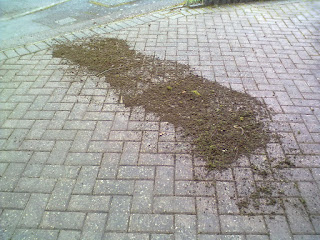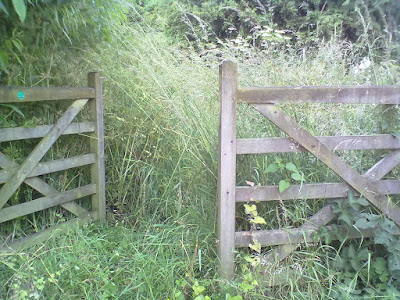In case you've missed this phenomenon, or in case you are thinking of having some laid, block paving is used when you don't want a boring concrete drive, and can afford to have something a bit posher.
It's made using paviours or pavers, which are like a slightly undersized house brick but without the "frog" or hollow on the bottom. They are laid on a bed of compacted sand (usually), and are set very close together. They are not concreted in place, so this method allows a certain amount of excess water to drain away, hip hip hooray. (Although still not a good idea if your drive slopes downwards towards the house...)
The advantage of a block paved drive over a solid concrete one, as well as the drainage, is that they can conform to changes in level, and they look nice. Very nice.
The disadvantage, from the viewpoint of the gardener or houseowner who has to maintain them, is that teeny tiny weeds can force themselves down between the blocks, so then they have to be weeded.
This - left - is a pretty typical herringbone block paving section, very much in need of weeding.
As you can see, debris has filled up all the joints, and now the weeds are rooting themselves down. If you leave them, they get bigger and bigger to the point where they start to lift the paviours, which is disastrous!
Up until that point, it looks lovely: much, much better than a solid concrete driveway - and not just in looks, but in water drainage - and ok, it's nice to walk on.... but once it need weeding, well, is that such a big problem?
If it were all in nice straight long lines - well, it would be tedious, but not really a problem.
But who invented the herringbone pattern?
What sort of demented sadist invented that dratted herringbone pattern!!!
Why does this stir me to such vitriol? Well, I have the joy of maintaining a biggish stretch of block paving for one of my Clients, and the other morning I noticed with horror that the section just in front of the door was all covered in weeds again, so I had to get out the long-handled wire brush and scrub it clean: moss holds the moisture and can make it very slippery, and I don't want my ladies having accidents!
And this is where the sadism comes into it: herringbone pattern has to be THE most annoying pattern to clean, because you can only ever do tiny bits at a time.
On a normal patio or path with nice big stone slabs, you go over it one way, you go over it the other way, sweep off the bits and you're done.
Not so with block paving: you can't build up a good rhythm, or getting any real vim behind it, because the most you can do is two blocks-lengths at a time. And then you have to go back and do the ones at right angles... all the while trying to avoid treading on the loose globs of mud and weed which you have already dislodged....
Here we are with the long-handled wire brush, tediously scrubbing one way, then the other.
You can see which bit I've done, can't you?!
Here we are a little while later, sweeping up all the loose debris into piles.
It's worth doing this every so often, to avoid that business of treading it all back in again.
"But," I hear you say, "you can just spray it with weedkiller, can't you?"
Well, yes, you can: but, just as with shingle, stone slabs and most other hard surfaces, if you spray the weeds then yes, they die, but you have to look at dead and dying stuff for a fortnight: nine times out of ten the dead stuff looks so hideous that you tell your gardener to pull them out anyway, so they might as well have done it the first time: you're using heinously horrible chemicals in a not-strictly-necessary situation, and - my personal favourite - by leaving weeds etc to die, they are just rotting down and adding to the matrix of soil and debris in which the next generation of weeds will root themselves.
So no, weedkiller is not usually the answer.
Instead I have to get out there and scrub the darned stuff.
I'm still in two minds as to whether it's best to do it old school back-breaking bend-over styley, with a daisy grubber: it does an excellent job but breaks your back, not to mention that it wears out the prongs, as you can see in this comparison photo, left.
..or to use the long-handled wire brush and do it standing up, which saves the back enormously, but kills your back muscles from all that intensive scrubbing action.
Either way, the finished result - right - is well worth the effort, not least because then everyone else in the street has to get out there and clean theirs, mwaah haa haaaa!
Did you enjoy this article? Did you find it useful? Would you like me to answer your own, personal, gardening question? Become a Patron - just click here - and support me! Or use the Donate button for a one-off donation. If just 10% of my visitors gave me a pound a month, I'd be able to spend a lot more time answering all the questions!!







